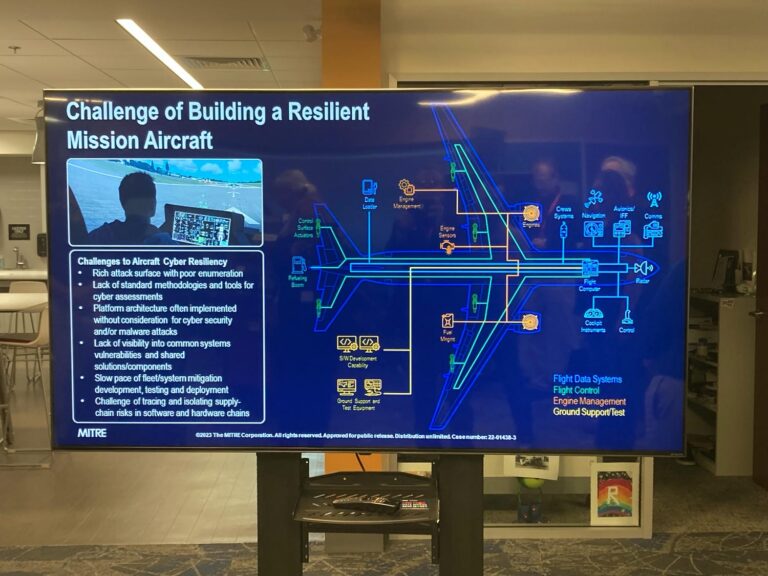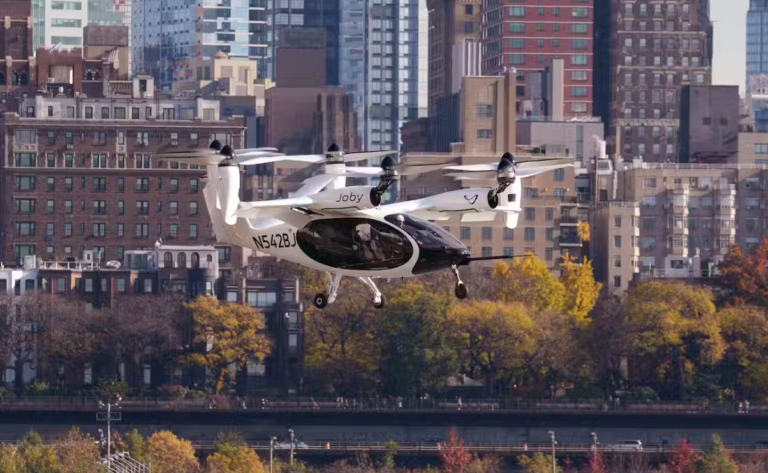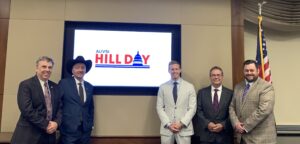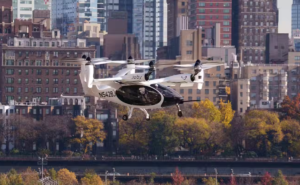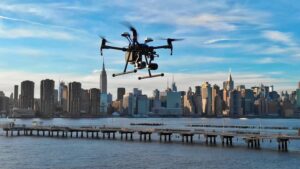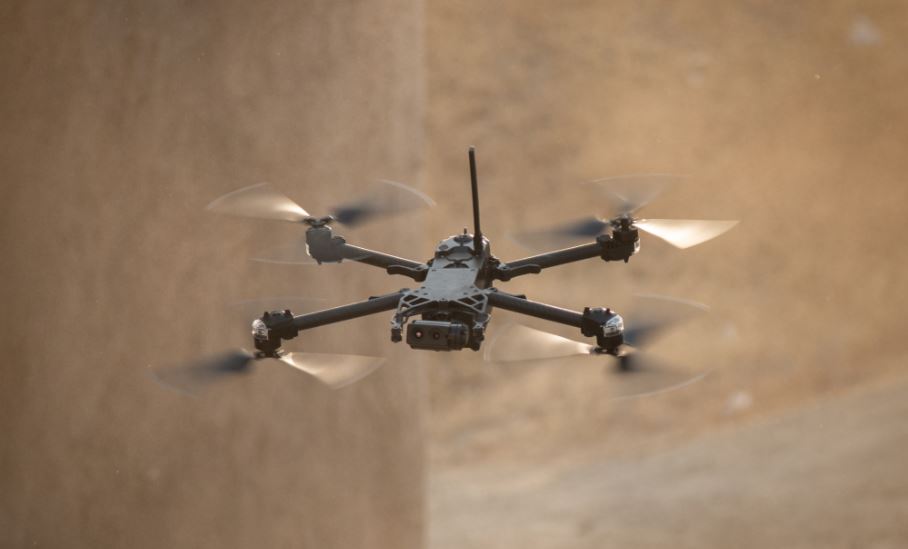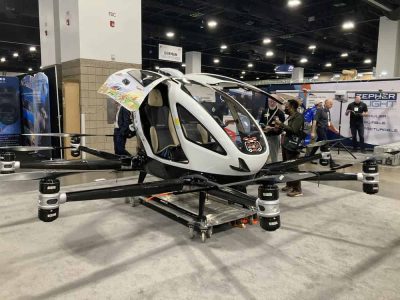AUVSI’s Michael Robbins – CEO talked about drone sightings along the Eastern United States and federal, state, and local concerns about their origin.

TRANSCRIPT:
This is Michael Robbins. He’s the president and CEO of the Association for Uncrewed Vehicle Systems, talking about the recent news concerning drone sightings in the United States. Mr. Robbins, thanks for your time.
Thanks so much for having me, Peter.
What’s your organization?
Yeah, so AUVSI, as you said, the Association for Uncrewed Vehicle Systems International, we represent companies that work in the uncrewed systems space, so that’s the air, ground, maritime domains in both commercial and defense. And we are sort of their voice on Capitol Hill or with the FAA, the administration, the Pentagon, and sort of advocating on their behalf for sensible, enabling regulations and for acquisition policy.
And it’s okay to call them drones, I suppose.
Sure, absolutely.
So when you hear about this week, or at least the last couple of weeks, about drone sightings in the United States, first and foremost, what the actual news, what went through your mind, and what do you think the public is saying and legislators are saying versus what your folks are saying?
Yeah, so we view this as an opportunity to talk to the American people and have a conversation about the beneficial uses of drones, of which there are many. Drones are an awesome tool for public safety, precision agriculture, medical delivery. There are many use cases that are being employed right now, including in New Jersey, where there’s lots of infrastructure inspection happening, roads, bridges, pipelines, power lines. Drones are doing inspection of all those things on a regular basis. So there’s a lot of positive use cases for drones. But at the same time, there are some pretty serious gaps in both drone-enabling policy as well as in the policies that enable UAS detection and mitigation, or drone detection and mitigation. So we view this as an opportunity to start having that conversation or continue a conversation we’ve been having with both the American people as well as lawmakers at all levels of government. And we’re hopeful that coming back in 2025 with a new administration and new Congress that there will be action on some of these issues that have been pending for many, many years.
What do you think of the level of concern that has been expressed, not only about the vehicles themselves, but the origin of the vehicles? And where’s the truth in what’s being said?
Yeah, so we take the federal government and its word when they’re saying from multiple agencies, FCC, FAA, DOD, DHS, that there is no threat to the American people or to the people of New Jersey. And there’s not any kind of imminent concern. That said, there’s every right for Americans to have their opinions on what is happening. I think there’s been a lot of misinformation, some of it intentional, some of it unintentional. And I think what we’re seeing is that a lot of people are maybe looking up for the first time and sort of paying a little bit closer attention to what’s in the sky at night and misidentifying what is maybe a crewed aircraft, maybe it’s a star, maybe it’s a satellite, and sort of thinking, well, that’s there at night, it looks a little different, it’s not moving really fast, it must be a drone. And often that’s not the case. That’s not to suggest that there aren’t some legitimate compliant drones operating along the eastern seaboard at night. There are, I mean, there are lots of missions that are drones that are undertaking compliantly and within the law. But I think what we’ve seen from the videos posted online, the overwhelming majority of them are either a hoax or just people misidentifying aircraft, including some very legitimate officials, members of Congress and others who think they saw something that they misidentified as a drone.
What misinformation have you heard?
Yeah, so there’s definitely been people, like with any thing that happens in the news, where people are trying to take advantage of the situation and suggesting that whether it’s, the government is controlling these drones or, I’m not going to repeat all the various hoaxes and myths, but there’s definitely been a lot of misinformation. And look, that comes with any situation, right? When we had dramatic hurricanes earlier this year, people suggested that government was controlling the weather. There’s been an online hoax that, you know, birds aren’t real. So, you know, there’s all kinds of things that occur in the news, and we’re trying to stick to the facts and have a positive conversation here about drones.
Michael Robbins joining us for this conversation. If you want to ask a question about drones and their use, 202-748-8000 if you live in the eastern and central time zones, 202-748-8001 if you live in the mountain and Pacific time zones. And you can also text us at 202-748-8003 if you want to post your, and you can also post your questions on Facebook and on X. When it comes to oversight of how drones are operated, how much comes from the federal government?
Yeah, right now, drone, all airspace is federal, so let’s, you know, clarify that. So, all aircraft, whether it’s a drone or a commercial aviation aircraft or general aviation, only federal authorities are regulating those aircraft once they take off. Local state officials do have some say around where they take off and land, with zoning, permitting, and things of that nature. But once the aircraft is airborne, it’s entirely federal authority.
And so then who exactly, what branches of the government deal with their regulation or their oversight?
Yeah, so it’s primarily the Department of Transportation and more specifically the Federal Aviation Administration on the safety and operation side. And on the security side, there’s also a role for the Department of Homeland Security.
There are, according to, this is from the FAA saying, “792,000 registered drones in the United States, this happens in October. Amongst them, commercial drones, 397,000, 388,000 recreational drones.” It goes on from there. That’s a lot, though. Is there enough being done or is there enough manpower being done to make sure proper oversight is done on how these drones are used?
Sure. Well, when it comes to drone policy, I think we can look at it two different ways. One, there’s the sort of enabling regulations. That’s what’s allowing people to fly in the airspace right now. And I would suggest that the policies that are in place right now are not enough to allow drone operations, particularly on the commercial side, to scale so that people start seeing on a more regular basis all the benefits that come with drones, whether again, that’s for public safety missions, search and rescue, or providing law enforcement, tactical intelligence, or critical infrastructure, doing infrastructure inspection, using thermal or electrical optical cameras to inspect power lines and pipelines and such. So many great use cases. But a lot of that is limited because the rules for enabling drones to operate at scale are not yet in place. And I think that’s part of what this challenge is, is people are seeing maybe drones and they’re like, “Oh, that drone, should it be there?” Because they’re not used to seeing them all the time. And when drones become more commonplace, when the rules are in place to allow for drones to, “Oh, I need an onion for dinner. I’m just going to order one on my phone and it’s going to be delivered seven minutes later,” instead of having to get in my car and get on our unsafe roads,
when things like these start occurring more regularly, people won’t have the same sort of reaction that they have now when they see a drone in the air, particularly at night. Because it is still somewhat new and novel, despite the number of drones that are in the airspace. On the other side, Congress hasn’t updated the federal authorities for UAS detection and mitigation since 2018. So a long time has passed, more than six years since Congress last addressed federal authorities for UAS detection and mitigation. And right now there’s no authority for state, local, tribal, territorial governments at all. So it only resists the federal level, and even that authority is extremely limited. The Department of Energy, the Department of Justice, the Department of Homeland Security, and the Department of Defense are the only four agencies that have that authority. And it’s not a standing authority. In order to actually use that authority, they need to get approval at a fairly high level of those different agencies. With the exception, really, of DOE protecting some critical infrastructure,
like nuclear sites, as well as the Department of Defense, you know, sort of having airspace awareness around the military bases.
There has been a national action plan released by the Biden administration in April of 2022 that has not been acted upon by Congress. There’s a bill in the Senate that has a strong support, has passed the Senate Homeland Security Committee. There’s a bill in the House that passed the House Homeland Security, but they did not come together to reconcile those bills. As you know, they’re leaving town in the next 24, 48 hours or so. So it looks like it’ll be at least, you know, January of 2025, where we have an opportunity to address expanding the authorities for UAS detection and mitigation, and potentially delegating some of that authority to state and local governments that they can have better airspace awareness. I think airspace awareness is key. When you have better awareness of what’s actually in the sky and say, oh, that is a drone or that is a commercial aircraft or that is a helicopter, you give people a degree of comfort that’s lacking right now.
This is Michael Robbins of the Association for Uncrewed Vehicle Systems. He serves as their president and CER. First call is from Susan from New Jersey. Okay, great. Susan, good morning. You’re on with our guests. Go ahead.
Good morning. Thanks for taking my call. I have a call from Mr. Robbins.
Question. If you’re having dinner with your family outside, your kids and your grandparents and a person literally sitting on a drone or a drone who you don’t know, came and hovered right next to your table, how would you feel?
Because I see that coming, and right now I found out that under U.S. law that’s totally allowed, and the police would not even be able to make that drone leave, because in 2016, the FAA took control over all airspace, including the air just above your backyard grass, and there’s nothing to stop drones from flying over there. And I live in New Jersey. I spend a lot of time outdoors. I watch the birds. I watch the stars. And, you know, I understand the companies you represent are working on dedicated drone corridors to support delivery routes. We all like delivery convenience, but will those routes be over my house?
You know, Europe has already figured this out. They have geotones and countries worked out, you know, where industry, local governments, real people,
they have an organized system, and drones can’t fly over your house unless they get permission. And we don’t have that yet. And, you know, I think people need to think about, do I want drones over my backyard? How close at all? And to speak out, because right now I think big tech is leading the charge, and our national government is right alongside them, especially with, you know, the Muskmobile coming to the air near you. So what do you feel about that?
We’ll leave it there for our guests to answer.
Yeah, great question, Susan. And certainly, you know, respect the perspective that you’re bringing to this conversation and a very thoughtful question.
Currently, whether it is a drone taking pictures of you or someone using binoculars or a cell phone camera or a telephotic lens, all of those have privacy violations. A drone is just a tool, no different than a camera phone that I have in my pocket and that you likely have at home or binoculars that you have. And if someone is spying on you and invading your privacy, the same privacy protections that protect your home from a cell phone camera are applied to drones as well. So I think you have a little bit of misinformation about, you know, what has been said about, you know, law enforcement not having any ability to address, you know, someone spying on you with a drone. That’s not quite right. But I can certainly understand that concern. With respect to drone delivery, when a drone is operating for delivery purposes, that drone does not have the same kind of cameras that a drone that would be taking, you know, high resolution photos would have. That drone is typically operating autonomously or with a remote operator that is, you know, sending that drone and it’s just operating its mission in any kind of cameras it has just for broader airspace awareness and for very limited purpose. And it’s not storing that video. So when our member companies are going into communities to launch drone delivery service, they go out of their way to meet with the community and sort of dispel myths and concerns that the community may have.
And certainly at times there is a little bit of trepidation because this is new and people don’t necessarily understand what these drones do and what they don’t do. But we have found overwhelmingly is that once drones start working in the community, again, whether it’s for delivery or public safety or infrastructure inspection, they are very much welcomed. And in fact, in certain areas of the country like in North Texas where drone delivery has really taken off, communities are actually competing with each other to see who’s going to get drone delivery next, because it’s such a great convenience to the people who live there. So again, it does take some public education does take some awareness, which is why I’m happy to join a C-SPAN today. This is Democracy in Action and having a conversation with folks about what is and what drones do and what drones don’t do. So thank you, Susan, for that question.
She talked about airspace over houses. Do you have a certain amount of privacy that way as far as the airspace over your house?
Sure. So again, all airspace is federally regulated. But again, in the same way that if someone was invading your privacy with a cell phone camera, those same privacy protections would extend to someone using a drone invading your privacy as well.
Let’s hear from Wayne in Pennsylvania. Go ahead.
Yes. I don’t know how many classes they send these people to to learn how to answer these questions. But 850,000 drones. And it’s just funny that we haven’t seen any of them or any reports for forever. Now, all of a sudden, there’s thousands of them in the skies.
And I understand there’s a container, a radioactive material mission in New Jersey, and they could be looking for those. But why all of a sudden is there are all these reports and all these drones flying people ordering packages from Amazon for Christmas?
So thank you for that question, Wayne, from Pennsylvania.
So according to FAA data from about 2023, so it’s a little bit dated right now, on a daily basis in New Jersey, for example, there are about 14 to 1500 flights per day. That’s a lot of drone flights. And you’re right. Maybe people didn’t really pay attention to them anymore. Drones are very, very small typically. They’re very, very quiet. And when they’re operating at day or night, most of the time, people don’t even notice that they’re there. So now, I think what we’re seeing in New Jersey is maybe a few drones were spotted, particularly at night. The drones that have been identified as actual drones certainly were operating compliantly. They have lighting on them, indicating that they’re not seeking to be there secretly, not seeking to be there stealthily. If you were seeking to do some sort of nefarious mission, you wouldn’t have navigation lights and strobe lights on your drone. So I think people, to my point earlier, are just starting to maybe look up and pay attention a little bit more. And then clearly, there’s been a lot of misidentification of other aircraft or stars or satellites as drones, when in fact, they’re actually not drones.
And as you say that, there’s a story today in USA Today, the FBI itself getting 5000 tips on those sightings. What does that number tell you about the level of concern?
Yeah. So I had some conversations with federal officials last night. I think they’ve taken those 5000 tips and actually narrowed that down to about 100 or so actual leads. So I think that tells you that an overwhelming majority of those sightings were not actually drones. And they’ve narrowed it down to a much smaller set of actual incidents that they’re seeking to investigate.
And I think, again, that speaks to the fact that while there certainly have been some drones and will continue to be drones flying at night, the overwhelming majority of what people think are drones are actually something else.
In those conversations with federal officials, what are you asking? What are they saying?
Yeah. So asking very same questions that a lot of your callers are asking and the American people are asking,
what is happening? Is it, as it seems, which to me, which is that there are a few compliant drones, maybe some uncompliant drones, or is there something larger going on here? And by and large, the overwhelming response has been no sightings of any uncompliant drones. There have been some a few compliant drones. Obviously, they’re operating, they’re doing their missions. And then overwhelmingly, things identified as drones that are not drones.
What about other countries? Are they flying these drones? Have you heard anything on that front?
You mean here in the U.S.? Yes. I have not heard anything on that front. We are certainly aware of other forms of intrusions into our nation, whether you have individuals seeking to break into military bases. We certainly have a very serious cyber problem that’s been well reported in the news.
Volt typhoon, salt typhoon, where foreign adversaries, particularly the People’s Republic of China, are probing our networks into our telecommunications, into our water, into our electrical infrastructure. Those are all very serious problems that we can verify right now. Is there the potential that foreign adversaries, foreign nations are using drones or other technologies to attempt to probe our military bases and others? Sure, that is possible, of course. But there’s no verification of that right now.
Let’s hear from Michael in Florida. You’re on with our guest, Michael. Go ahead.
Hi. Good morning, gentlemen. I enjoy the program. I have a couple statements and a few questions. My first statement is I feel that it’s an insult to the American public to say that, oh, in general, you look up, you really don’t know it’s a drone, we’re not used to looking up in the sky. I don’t buy that. I think that within a day that the federal government could find what these drones are and just not find what they are, where are they originating from and what are they doing? That’s my statement. The question is, I hear that they may be looking for radiation exposure. That may be true or not, but I just feel that in general question and a general statement saying that the American public doesn’t really know what a drone is. A drone, it’s like so slow or it doesn’t have a lot of space when it’s going over a certain neighborhood. And the size of these drones, I just feel it’s such a downplay to the intelligence of the American population to say that they don’t really, usually a public does not look in the sky. They don’t really know what they’re seeing. I feel that it’s a little bit more just because of the actual quantity and the actual size of these drones. What do you think about that? And one more thing, how many deliveries are you doing at 9, 10 o’clock at night? Do we have deliveries going on at that time of the hour?
Okay, Michael, thanks. Yeah, great questions, Michael. So I’ll address your last question first. There’s not a lot happening on the drone delivery side at night, but certainly there are a lot of other missions that are occurring at night, whether it’s public safety, most crime occurs at night. So a lot of local law enforcement use drones as tactical first response, you know, drones for search and rescue and other missions at night, as well as infrastructure inspection using, you know, thermal or I.O. cameras to inspect, you know, various infrastructure to ensure that, you know, that remains safe or to get things that have crashed back online.
With respect to, you know, your concern around, you know, the American people and what they are or are not seeing, let me give you two very tangible examples.
The governor of Maryland, certainly a well-informed individual, took videos of what he purported to be drones in his backyard. The next day he had to walk back those videos, and what he was actually taking videos of was the constellation Orion. He was looking at stars.
The congressman from New Jersey, I believe his name is Andy Kim, senator-elect, he took videos. He went out with local law enforcement in New Jersey, took videos of, again, what he thought were drones. What he was actually viewing were commercial aircraft on approach and landing. There’s something in the night sky called the parallax effect. When you’re looking at a light, it’s very hard to tell how far away it is, how fast it’s moving or not moving at all. There’s optical illusions with lights at night. So when you have that parallax effect occurring, things that could be mistaken as drones are clearly now being mistaken as drones when they’re actually something very, very different from drones. Take those two examples from two very well-respected elected officials and extrapolate that many, many times over throughout the American public. I think that is what’s leading to this sort of media frenzy that we’re having right now.
Let’s hear from Shannon. Shannon, also in New Jersey. Good morning. Thanks for calling.
Yes, thank you so much. I really appreciate this segment. So I was actually just wondering, there’s been obviously a lot of video circulating online. There’s videos of potential drones or UFOs over the Capitol. I wanted to see if you have any tips or suggestions for citizens to remain literate around as more of these videos circulate. Like, can they be generated by AI or are they real videos? Are there any suggestions you have for that?
Sure. Yeah, great question, Shannon. Thank you so much. I know that some social media sites do designate a video if it’s clearly been used, generated with AI so that folks can make informed decisions. I have seen a few videos myself that are very clearly altered or fake. Sometimes you can tell by watching what else is in the background and see that it’s maybe on a loop or that the images are distorted. But just by and large, I don’t have any great tips for cutting through what’s real, what’s not real. I have the same problem with everybody else sometimes in sort of trying to distinguish between fact and fiction. Just try and think through the issues, listen to and trust in our authorities and understand that everything should be looked at with a certain degree of skepticism when it’s posted online, particularly not from verified sources.
If the authority for drone operation ultimately comes from Congress, what should Congress offer to clarify what’s going on currently and to resolve some of the issues that are going on currently?
Yeah, I think there’s a couple of things Congress should do. One, they should hold the FAA accountable for instituting the rules that will normalize drone operations so that we can get past this sort of, you know, this is rare, this is unique. And drones become part of our regular everyday lives, like many other forms of technology and many other forms of transportation, so that we don’t have this sort of skepticism of drones in the future. Congress needs to update UAS detection and mitigation policy. As I mentioned, it’s been since 2018, since those rules have been updated. A lot has changed since 2018. And that has leading a lot of state, local, federal, tribal, state, local, tribal, territorial law enforcement leaders, really without any kind of tools at all and relying upon, you know, the federal agencies, which have very limited budgets, very limited authority as it stands right now. So those rules need to be updated. And lastly, this is not unique to drones, but as a whole, we are under investing and investing in some cases in the wrong things with our national airspace. You know, whether it’s, you know, our air traffic control towers or, you know, our traffic controllers using paper strips to control air traffic the way they did in the 1960s, 95% of air traffic controllers are still controlling air traffic, you know, using paper strips in 2025, 2024. That’s wild. And I think it’s indicative of the fact that we’re spending a lot of money on our air traffic organization, keeping, you know, technology that’s decades past its intended use and lifespan still online instead of investing in new modern technology that would give us much better airspace awareness and would help to provide information. Information is often, you know, the key to comfort and understanding. And right now we lack a lot of information because we haven’t invested in our air traffic system the way we should be.
This is Don from Wyoming. Hello.
Hey, good morning, fellows. Enjoying the show. So my questions are this. I’m a part 107 license holder, and part of my curriculum pointed out, highlighted that in order to operate a drone over traffic,
over public spaces where people were present, you had to file a flight plan with the air traffic control request, an exemption for flying over traffic or over the public, and where the public is involved, you would have to notify the public that they’re entering that operation area. So I’m baffled by the notion that we don’t know where these drones are coming from, because if the flight plan isn’t approved by the air traffic toll or the exemption granted by the FAA,
then the drones indeed are flying illegally and putting the population at risk. And I’ll take the response off the air. Good morning.
Thank you, Don.
Yeah, Don, first, congratulations on getting your part 107 certificate.
What is that button?
Yeah, for those that don’t know, that is essentially the license to be able to operate drones in the U.S. Beyond just the recreational flying, you’re really doing some sort of a service, commercial drone operation. So congratulations to you. I think you’re absolutely right in that there are certain segments of the airspace where you do need to have FAA approval to fly, and that approval of Lance is very easy to get. It’s typically done online. You get approval from the local tower in relatively short time span. And I think that actually speaks to the fact that because we have some rules and regulations in place, we certainly do need more. But, you know, compliant operators like yourself, 107 operators, are following the rules, and they are doing things the right way, which is giving federal authorities the ability to understand what’s in the air and have airspace awareness. I think where there is a shortcoming is when you do have people that are not operating under 107 or are not seeking Lance authorization and they’re flying in airspace, but maybe they shouldn’t. I think that happens very rarely. It’s not something we hear happening on a regular basis, despite this current speculation that drones are doing more than what they really are.
In those cases, you do need to have the U.S. detection and mitigation technology and policies in place that I’ve been discussing to give all levels of government better airspace awareness.
A-U-V-S-I dot org, the website for the Association for Uncrewed Vehicle Systems, Michael Robbins, serving as the president and CEO. Thanks for your time. Thank you, Pedro.




